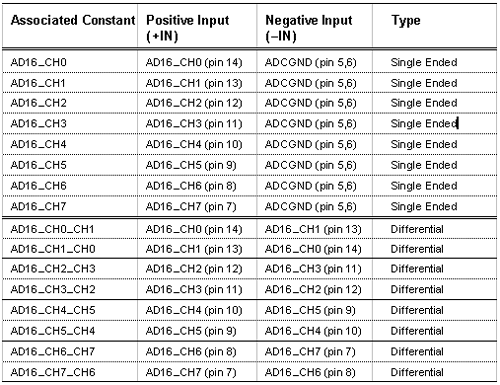


 |
 |
 |
Table of ContentsConnecting To Mosaic Controller Selecting the Wildcard Address Selecting the Reference Voltage Analog I/O Wildcard Field Header Overview of the Software Device Driver Functions Initializing the Analog I/O Software Drivers Installing the Analog I/O Wildcard Driver Software |
Analog I/O Wildcard User GuideUsing the A/D DriversThe eight input lines of the Analog I/O Wildcard can be configured as either eight 16-bit unipolar single-ended input channels or four 16-bit unipolar-differential input channels. In single-ended configuration, the convertor can digitize only positive ground-referenced voltages. Each differential channel pair can also only convert a positive differential voltage, but the channel pair can be reconfigured to swap the polarity of the inputs so that a negative difference voltage can also be read. Consequently the four differential inputs can each be reconfigured so that there are a total of eight differential input combinations. The A/D converts the positive voltage difference between a greater, "positive" input (+IN) and a lesser, "negative" input (−IN ) into a digital number in the range 0 to 65535, with 0 corresponding to +IN = −IN and 65535 corresponding to just under +IN − −IN = Vref. If the voltage on the −IN pin is greater than that of the +IN pin, the conversion result is zero. In single-ended mode the −IN input is connected to ground and eight input channels of +IN are provided for reading positive voltages referenced to ground. In differential mode, the +IN and −IN are assigned to different input channels, and the positive voltage difference, +IN minus −IN, is converted. The −IN input must be kept within the range −0.2 V to +1.25 V, and should not be greater than the +IN input. The +IN input must be kept within the range −0.2 V to +5.2 V and produces meaningful results for values from the −IN input value up to the −IN input value plus the reference voltage. Because both the +IN and −IN input voltage ranged extend well below ground (to −0.2V), voltage differences near or slightly below groun\d can be read. Further, the +IN can range up to 5.2V. The sixteen different input options are itemized in Table 1-6.Table 1-6 Analog Input Connection Options  |
Home|Site Map|Products|Manuals|Resources|Order|About Us
Copyright (c) 2012 Mosaic Industries, Inc.
Your source for single board computers, embedded controllers, and operator interfaces for instruments and automation